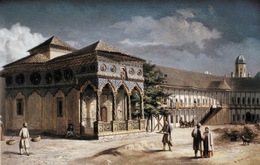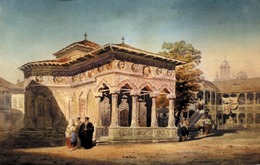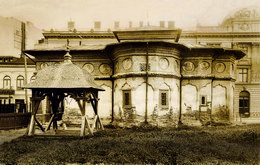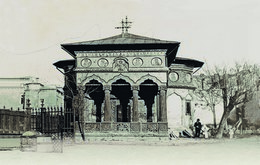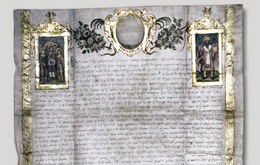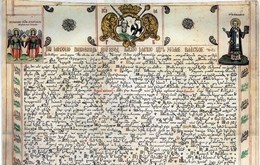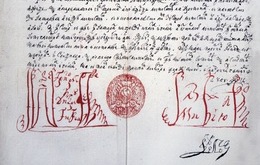The Monograph
The Western traveller visiting the Bucharest of the 17th century for different reason may have stopped for a rest at famous inns. With solid and monumental structure, the great inns in Bucharest appeared in close connection with the increase of economic life, the increase of commerce and the beginnings of diplomatic life in the capital of Wallachia after years of Turkish domination.
Testimonials of missionaries, diplomats and foreign merchants talk about solid brick walls that surrounded the square yard communicating with the street through a single gate, having buildings all around the walls inside the yard, being an integral part of them.
The very buildings of the inn included cellars, shops and housing rooms. Many inns located in centre of Bucharest had their churches or monasteries right in the middle of the courtyard; some of them appeared as annexes of the churches or monasteries, built by the hegumens to increase their income.
The monasteries Coltea, St. Ecaterina, St. Ioan, St. Mihai Voda, St. Spiridon, Sarindar, Zlatari and Ghiorma Banul (known as the Greeks’ Monastery) got large inns in Bucharest. Stavropoleos Monastery is one of the kind, but in its case the inn preceded the church building. The construction of Stavropoleos inn and church is linked to the name of Greek monachos Ioanichie who came from Ostanitza village of Epirus, as he confesses in his will, in 1733: “For these my humbleness, from my early youth I have chosen the monastic life and I have worshiped the Lord, leaving aside the world’s waves, at the honoured holy monastery in the Pogoniana eparchy, dedicated to saint Archangels Michael and Gabriel, called Gura, and situated near the Ostanitza Village, that is my homeland, built on a large rock”.
Appointed as archiereus, “ordained as archiereus of Stavropoleos by ecdosis of his Holiness Ecumenical Patriarch Kir Jeremiah, our lord and master”, Ioanichie bought from Lady Despa, on 6 April 1722, a building plot near the monastery of the Greeks: “me, Despa, the wife of treasurer Carstea Popescu and mother of his son Tudoran, together with other children of mine, give a deed to his Holiness, archimandrite Ioanichie from Pogoniana from the Monastery of Saint Archangels, in order to inform him that we sell the building plot from the suburb of Ghiorma Banul and also the houses of Logofat [chancellor] Radu. Because of my husband’s debts, that plot is sold by His Holiness Father Daniel, bishop of the country and by the merchants signed in the act that mentions the division of the house in order to pay the debtors”.
The place sold by Lady Despa stretched from the walls of Constantin Voda’s inn (the former Post Palace) up to Smirdan Street bordering the properties of the Serdar [Grand Commander] Grigorie Greceanu and Logofat Radu’s houses.
On 1 June 1974, the Serdar Grigorie Greceanu offered the church a stânjen (about 2 meters) of place because “His Holiness, Father Kir Ioanichie, wanted to build a church inside his inn on the place owned by the treasurer Carstea, here in Bucharest, in the suburbs of the Greeks, near to my house. The place being too narrow, they came and ask me to sell a stânjen of land so that there be enough room for the altar. So when I saw that His Holiness did not have enough place, I offered a stânjen of land to the divine and holy church that has the Holy and Great Archangels Michal and Gabriel as patron saints, in memory of our souls. In my turn, I bought that place from Lady Despa, Carstea’s wife. That is why I gave this letter to his holy hands”.
Therefore, on 8 Novemer 1723, Ioanichie dedicated the Stavropoleos Monastery to Gura Monastery of Eparchy Pogoniana in Epirus. This fact is certified by the royal charter mentioned above and given to him by Prince Nicolae Constantin Mavrocordat.
On 21 May 1741, having already taking care of what he would leave behind, Ioanichie made a written document, certified by Metropolitan Neofit, about his successor as head of the monastery and its assets, in the person of his nephew, hierodeacon Partenie.
“Trying to finish the other monastic cells and anything else I might add, as a mortal fearing a sudden death, lest after my death the decisions I took in Diata (covenant) and my wishes stop by an obstacle, I thought it fit to leave after my death a worthy successor. By the mercy of the Lord, being now in a good health and clear-headed, I want to leave my nephew, hierodeacon Partenie, my sister’s son, as successor to supervise and to manage this holy church and as heir to all its properties, be it lively and inanimate, movable and irremovable goods, in accordance with my will. I know him be obedient, pious, leading a simple life, peaceable and full of zeal for the church and the holy issues, which took the monastic life by his own free option. He will be my successor that will keep count of revenues, together with the other epitropes and all the surplus he will send to Monastery from Rumelia. Also he will examine together with the other epitropes, hegumens and proestos [the highest ranking monk] of metochions [succursal monasteries, dependent monasteries] and in the case one of those does not have a proper behaviour and does not manage properly and does not offer the proper donation to metanie [a parent monastery of a monk] monasteries, he should be replaced. Also, the above mention heir of mine should have the right to choose a worthy successor, at the right time. The one who will dare to disrespect my decisions and will trouble my successor and heir, whatever rank he might possess, and the one who will alienate one of those goods, be lay under the ban of the church, curse upon him the anathema of the 318 Saint Fathers and God-bearers from Niceea and from the other saint councils, and let him be on the same side with Judah, the traitor, until he will do penance and leave this misdeed off and will be blessed with remissions!
After my death, the above-mentioned heir of mine will do the memorial services, according to my Diata. I made the present document to certify my will, during the reign of faithful Voievod Ioan Constantin Nicolae Mavrocordat, and I gave it to the above mentioned hierodeacon Partenie, my nephew and my heir.
Certified by my own signature and my own seal, in front of the honoured and worthy of credence, witnesses, the undersigned.
Ioanichie of Stavropoleos, I certify”
Partenie (1742 – 1749), the second hegumen of Stavropoleos Monastery proved to be prodigal with the monastery assets, so that he will be expelled after only seven years, being replaced by hegumen Matei Ierapoleos from Ghiorma Church.
Matei Ierapoleos (1749 – 1763), was as diligent as his predecessor Ioanichie. During his leadership the monastery acquires the Sarbeni estate, Gratia estate, as well as the church and the estate of Draganesti, the royal ”mercies” certified by royal charter of Voievod Scarlat Grigorie Ghica, renewed by Voievod Constantin Nicolae; and after that, the estate Pitarul in Vlasca county. Other documents mentioned him engaged in lawsuits for various legacies, at the Divan.
Chiril or Chirul (1781 – 1785), Matei’s successor, he is mentioned by very few documents. On 27 August 1781 he was at law for a widow’s house in the suburbs of Fintina Boului; and on 29 March 1785 a document signed by hegumen Chiril mentioned a negotiation act for a mill on Roata estate.
Timotei Arhiereul (1785 – 1823) recovered, at the request of Voievod Constantin Mavrocordat, a part of the Greeks estate, alienated by Partenie in spite of the fact it could not be sold, in accordance with the act of donation. He is also mentioned by a report of Vornic [governor] Dumitru Racovita, on the accusation of the bishop of Buzau regarding a metochion [succursal monastery, dependent monastery] near to Stavropoleos Monastery, as well as by a convention act regarding a mill on a ford from Roata estate.
Pahomie (1824 – 1828) is mentioned by documents of the State Archives with various properties related-causes: a pub on the Cartojani estate, in 1825, the act of donation of 10 stânjens to Roata estate, in 1827 another 20 stânjens to Roata, the act of donation given by Voica for nine stânjens of Roata estate.
Timotei (1828 – 1837) Archimandrite Timotei is named hegumen of Stavropoleos monastery, by order of Voievod Grigorie D. Ghica:
”with the consent of His Holiness the Metropolitan, I issued a decree addressed to venerable archimandrite Timotei, which I named hegumen of Stavropoleos Monastery in Bucharest, to replace the hegumen that served in that place before. So when he arrives at the monastery, he will make the zapis [deed, record] of all movable and irremovable goods that the monastery has to keep in good standing. He will repair and restore the damaged for the monastery not to get into a state of ruin; he will pay debts of the monastery and will manage well the heritage of the monastery, bringing it to profit. In short, the named hegumen be compelled to administer the monastery in accordance with the rules of the church that are mentioned in the testament – all this in order to point out the proper oikonomia and his acts of merit. That’s why we command to parents and worshipers of the holy monastery to show submission and obedience to the hegumen; so that he can commit the monastery affairs flawlessly.”
While taking care of the things needed for the moment of his death, Timotei made his testament, on 29 April 1832:
”Being mortal and clear-minded, and not knowing, as the Holy Gospels says, nor the day or the hour of my death, I decide that my properties and the properties of Stavropoleos Monastery should be distributed as follows:
1. Hierodeacon Antim – sent by the Metropolitan Monastery with a letter sealed by the seal of our monastery, dated 8 May 1831 – he will be my successor, fully empowered to take the lead of monastery.
2. The groschen obtained from the sale of my wine this year – that is ten thousand groschen – be stored in a single location. The annual interest received by selling my wines this year be sent to my country, Ostanitza, to give it to the teacher of there, who, being learned and obedient, will teach the kids of my village and of surrounding villages, in memory of me.
3. For the many services my nephew Spiru and Elena, his wife, rendered to monastery and to me, the proestos [the highest ranking monk] and the epitropes in the forthcoming periods let them live in the room where Haralamb lived or in the teachers’ room, to live there for life, without any rent. I bequeath one hundred royal gold coins to the same nephew and one thousand groschen to his wife, for the care they had for me. I bequeath 500 groschen to my soul child, orphan, for school and clothing and for other necessities.
4. I bequeath 150 groschen to each priest of my village Ostanitza, for they commemorate me there.
I bequeath 50 groschen and nothing else to each relative of mine until the sixth grade. I bequeath 500 groschen to my nephew from here, Anastasie.
5. I bequeath 100 royal gold coins to my brother; he may give whatever he wants to his sons; and to commemorate me.
6. I bequeath to my nephew Gheorghe a deed of six thousands groschen of monasteries Stilos and Divreos, for him and his heirs to use the interest and each of them make Panikhida [memorial service] for me every year.
7. I compel the epitrope [administrator] Gheorghe Paapa to bring into being all of the above mentioned commands; to order, for the beginning, all the necessary stuff for the salvation of my soul and all Christian duties for a period of three years; to recover all the groschen mentioned in my deeds from debtors, and to gather all the money, and the groschen from my vineyard for that year; and after he give every person all the above mentioned things, to keep for my soul and to give the poor, taking a receipt for the donated amount, and to send the rest to the Monastery of Epirus. I bequeath to my hegumen a deed from the dead Facalina, regarding 1500 groschen he has to collect and to give them to Aglaia, his daughter, as dowry. I bequeath a silver plate from Russia and a silver jug to Aglaia; I bequeath to my epitrope the blessing of God and of the Mother of God.
8. I bequeath to my successor, hierodeacon Antim, a giubea [a broadcloth coat worn by the priests] in good condition, a new soutane, a kamilavka, my frock; I bequeath all the other clothes to Elena, Spiru’s wife, for she cared about me under any circumstances.
9. I bequeath to sacristan from the downside of the cemetery my vineyard from Valea Larga, bought with my own groschen.
10. I bequeath 250 groschen to Priest Ioan.
11. Anyone, relative or stranger, that will try to spoil this will of mine be cursed by God and by all saints.
Timotei of Stavropoleos, I testify”
On 1 May 1832, his testament is supplemented with a list of personal assets that Timotei gives to the holy monastery, indicating that those assets cannot be alienated.
“I give the monastery ten silver spoons, knives, spoons and forks, to be used at the memorial services, by the priests that will come, as well as the other goods as shown below:
One piece of wood saint
One piece of the relics of St. Haralambos
One piece of the relics of St. Procopius
One piece of the relics of St Panteleimon
One piece of Ignatius, the God-bearer
One piece of Eustratius, martyr
One piece of George, the Victory-bearer
One piece of Saint Chrysostom
One piece of Saint George, the same
One piece of holy relics of an anonymous
One piece from P.P.
One piece of St. Andrew
One piece myrrh Saint Dumitru
One piece myrrh his grace Athenagoras, Bishop of Thessaloniki
One piece of Saint John Prodrom
One piece of Saint Peter, anonymous
One piece of cross with some wood
One piece of Saint Gregory of Decapolis
One piece of Saint Theodor Tiron
One piece of Saint Basil, the hand
One piece of Saint John the Merciful
21, meaning twenty-one pieces, they remain forever in our holy monastery <and> which cannot be alienated.
– Timotei Stavropoleanul, I testify
– Gheorghe Popa, who wrote, witness
– Caminar [boyar who collected duties on spirits] Costantin Buri, confesses that himself Kir Timotei Stavropolitan told me verbally that this is his testament and I signed
– Antim, deacon, witness in a hurry, without reading contents
– Spiru Nicolae, witness
Starting with 1837 Timotei’s successor will not be Antim, the deacon, as appointed by his testament, but the protosingellos [the monastic rank below archimandrite] Leontie.
Leontie (1837 – 1859)
Dismissed from the hegumen rank by Department of the Church Affairs, on 20 September 1837, and replaced by Father Gheorghie the Treasurer, protosingellos Leontie is brought back as hegumen on 11 October 1838. Being accused of not having sent the long lease of Valea Monastery, Muscel District, to Gura Monastery, he is probably found not guilty; proof of it is the documents that mentioned him as head of Stavropoleos Monastery till 1859.
Both the inn and the church were generously endowed by the Phanariots, the hegumens received hrisovulion [princely decree granting property] confirming the donations. On 13 January 1733, Constantin Nicolae Mavrocordat donated to Stavropoleos Monastery the princerly vinarici (the entitlement to levy tax on vineyard owners and wine producers) from hill of Boldesti and Malaiesti. On 15 January 1853 Voievod Matei Ghica certifies the donation through the donation book about the rights of the monastery:
“every year, on the occasion of the feast of Saint Archangels, 50 tallers should be taken from the royal treasury and should exonerate from taxes 300 beehives, 300 pigs, 20 pogons of land, the vineyard, and 250 sheeps, and also the cells of the inn, the grocer’s shop of the inn, the cellar; the innkeeper, the grocer and the publican innkeeper should be exonerate from all tribute and orders imposed by the Treasury during the year, they should not be deranged by anything. Also, shepherds, bee masters, cowherds, wine growers will be exonerated from tribute and treasury decisions for the taxation-exempt of the saint monastery.
After that, my father Voievod Grigorie Ghica, fallen asleep in the true Faith, together with my uncle, Voievod Costantin Nicolae and Voievod Mihai Racovita confirmed this decision by royal deeds“.

